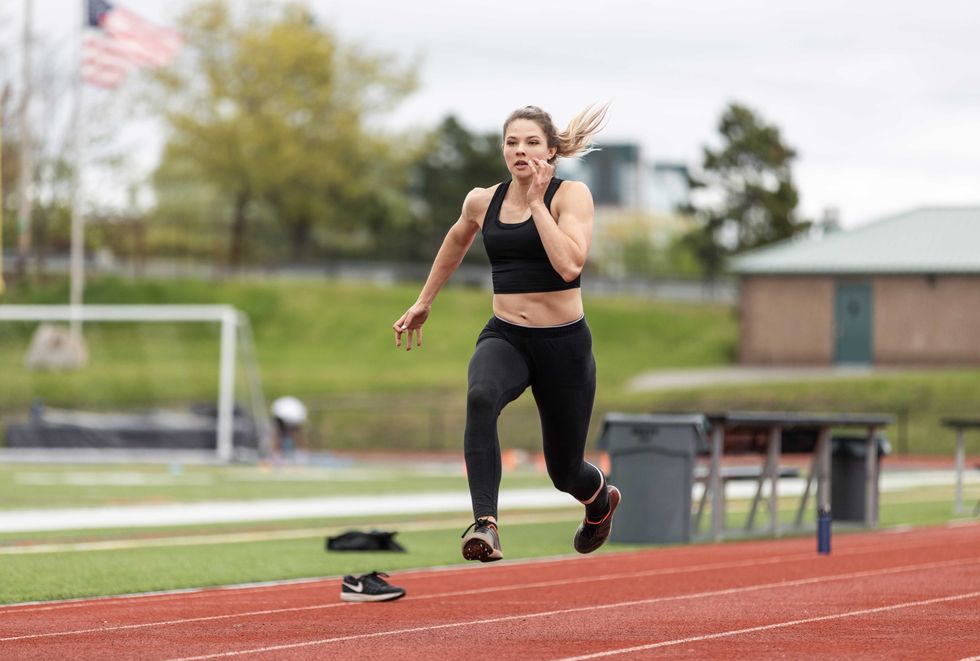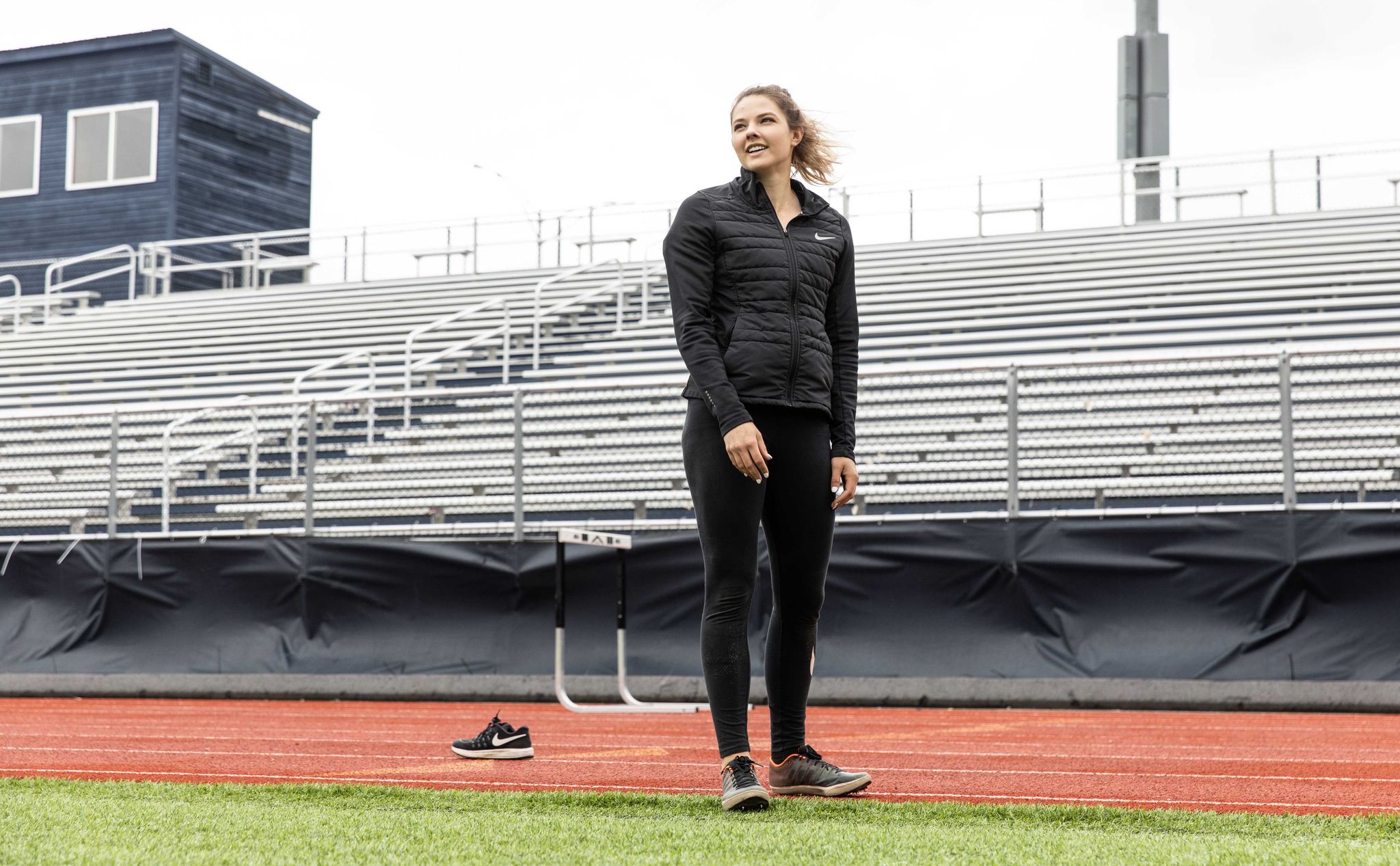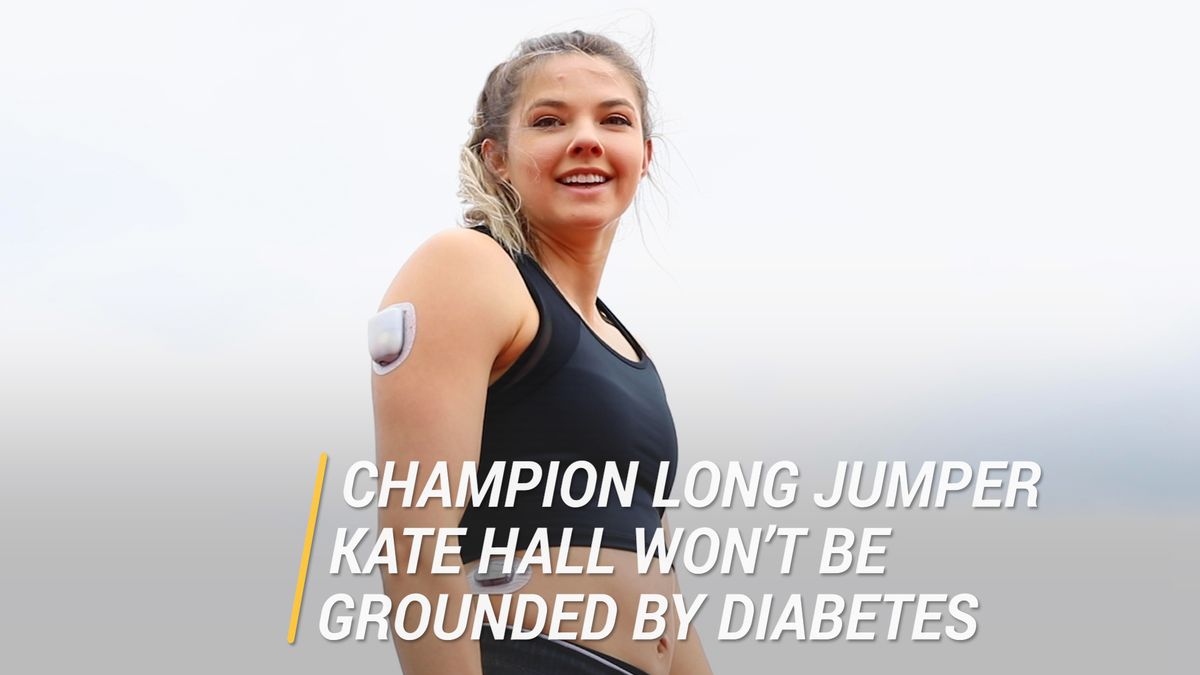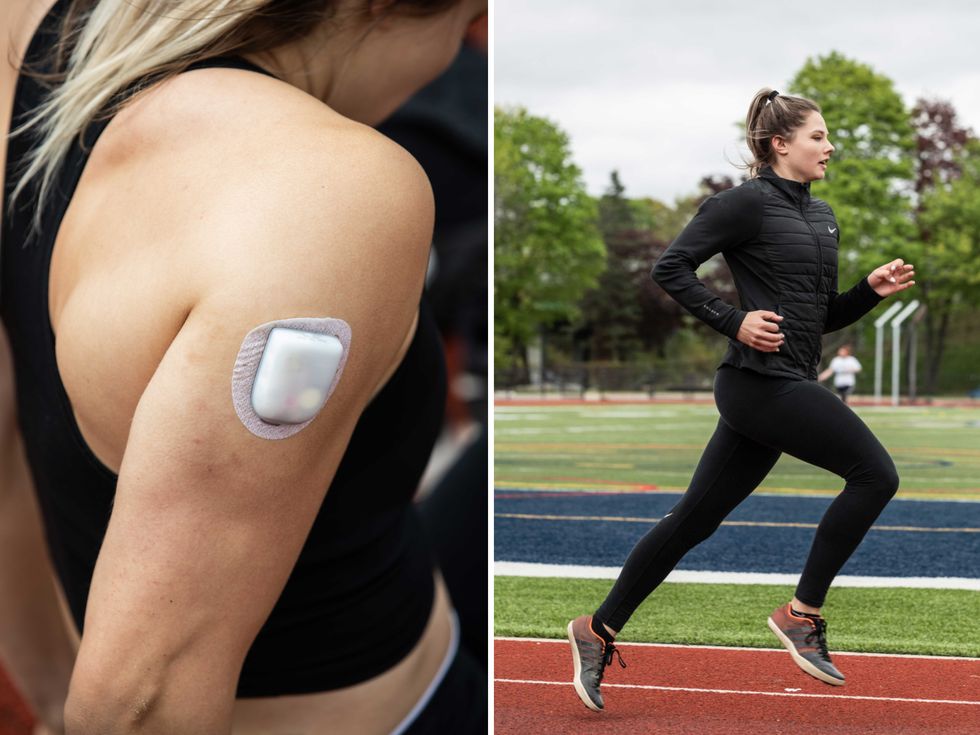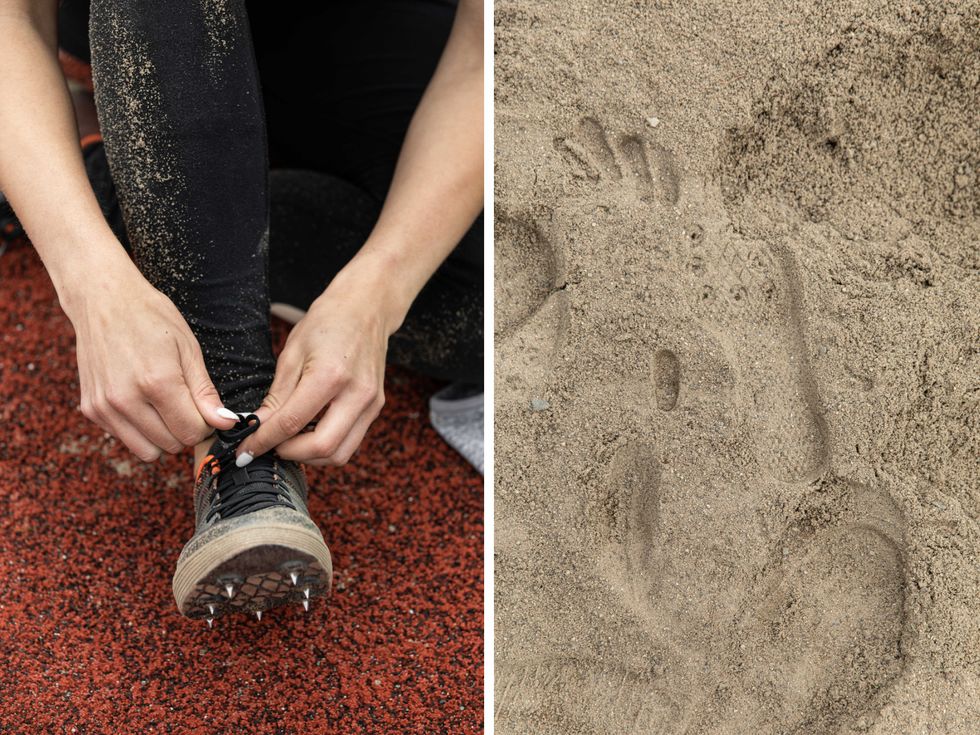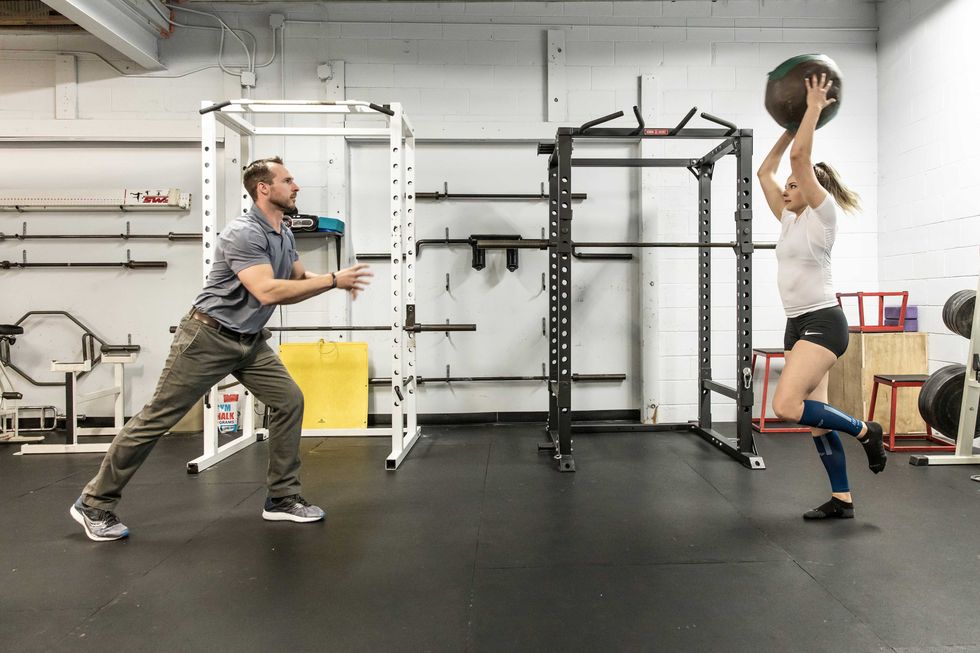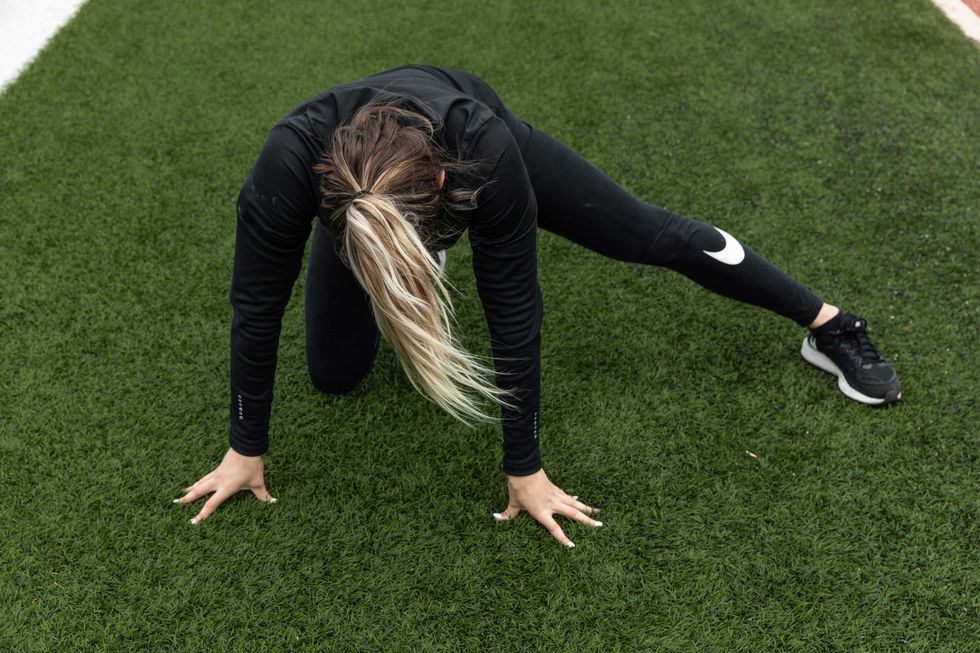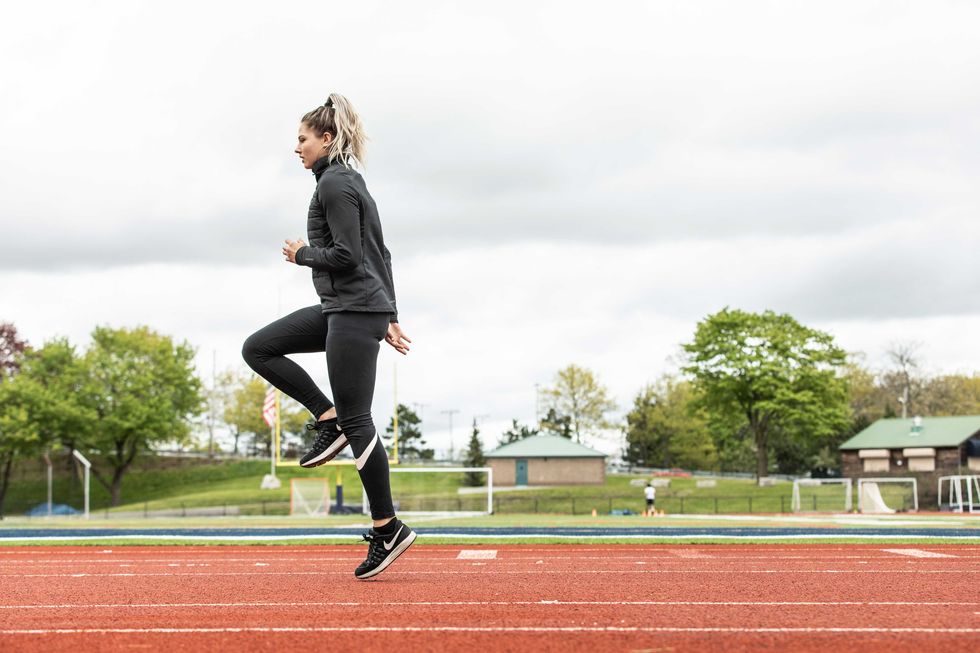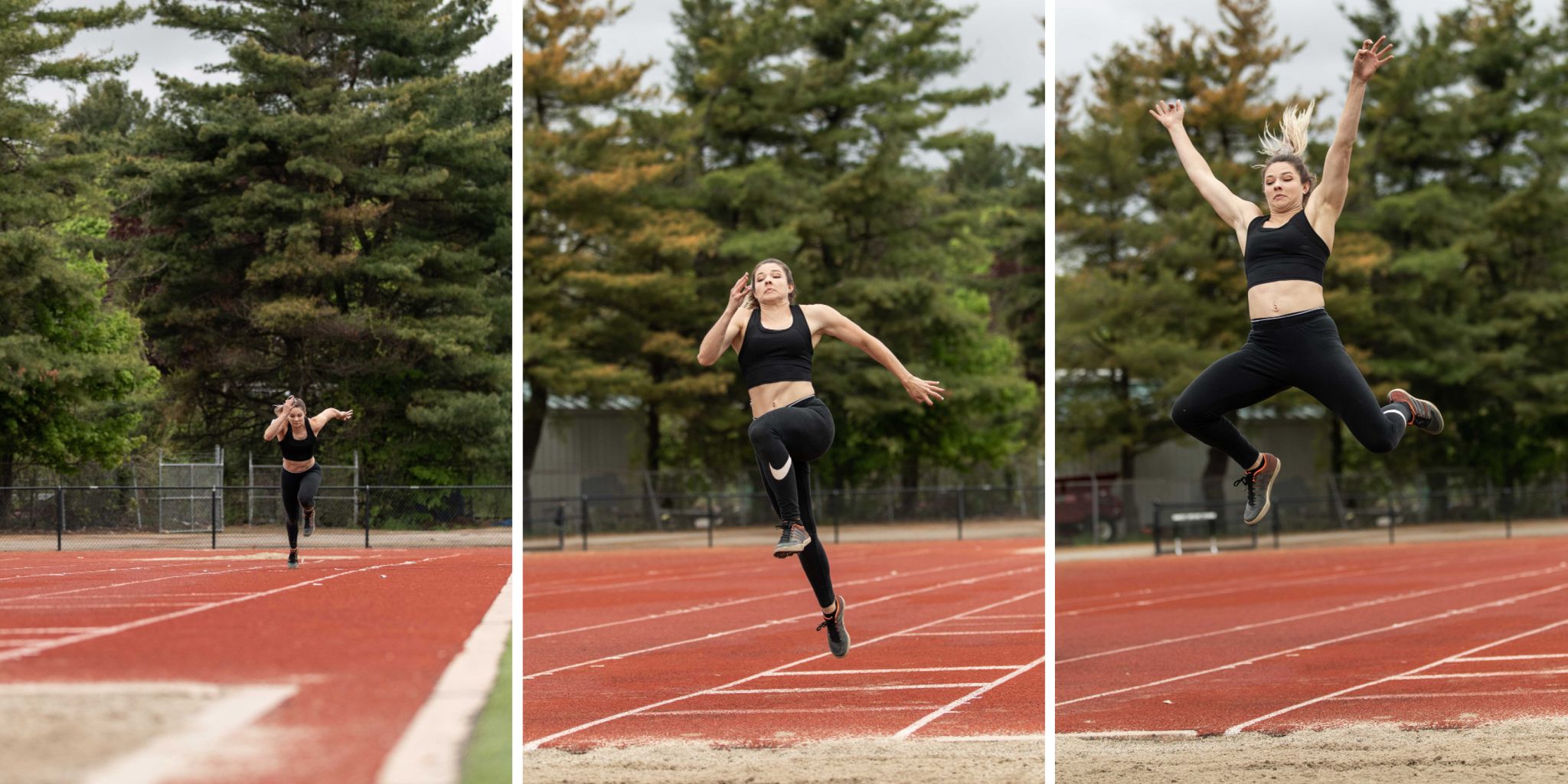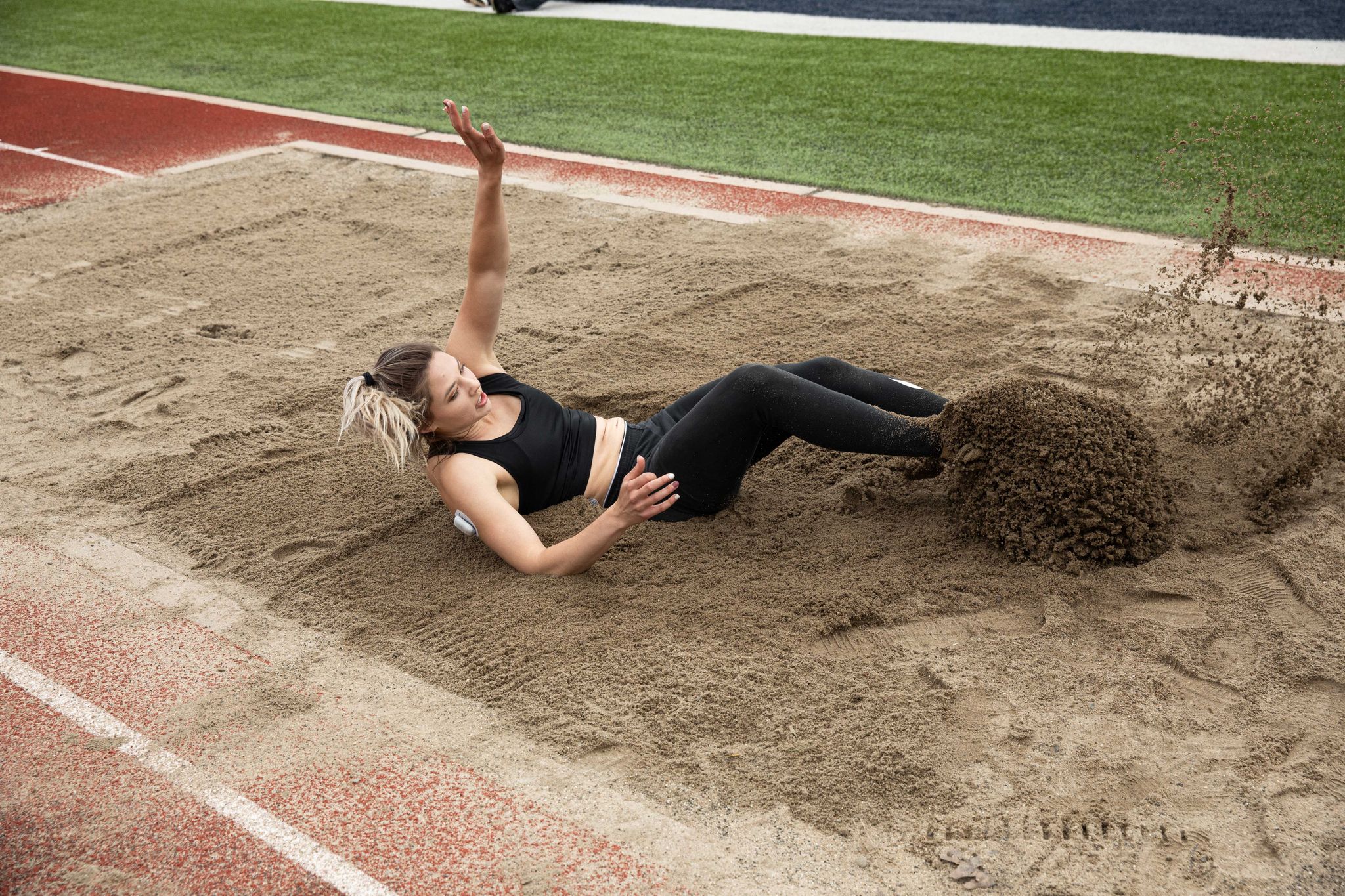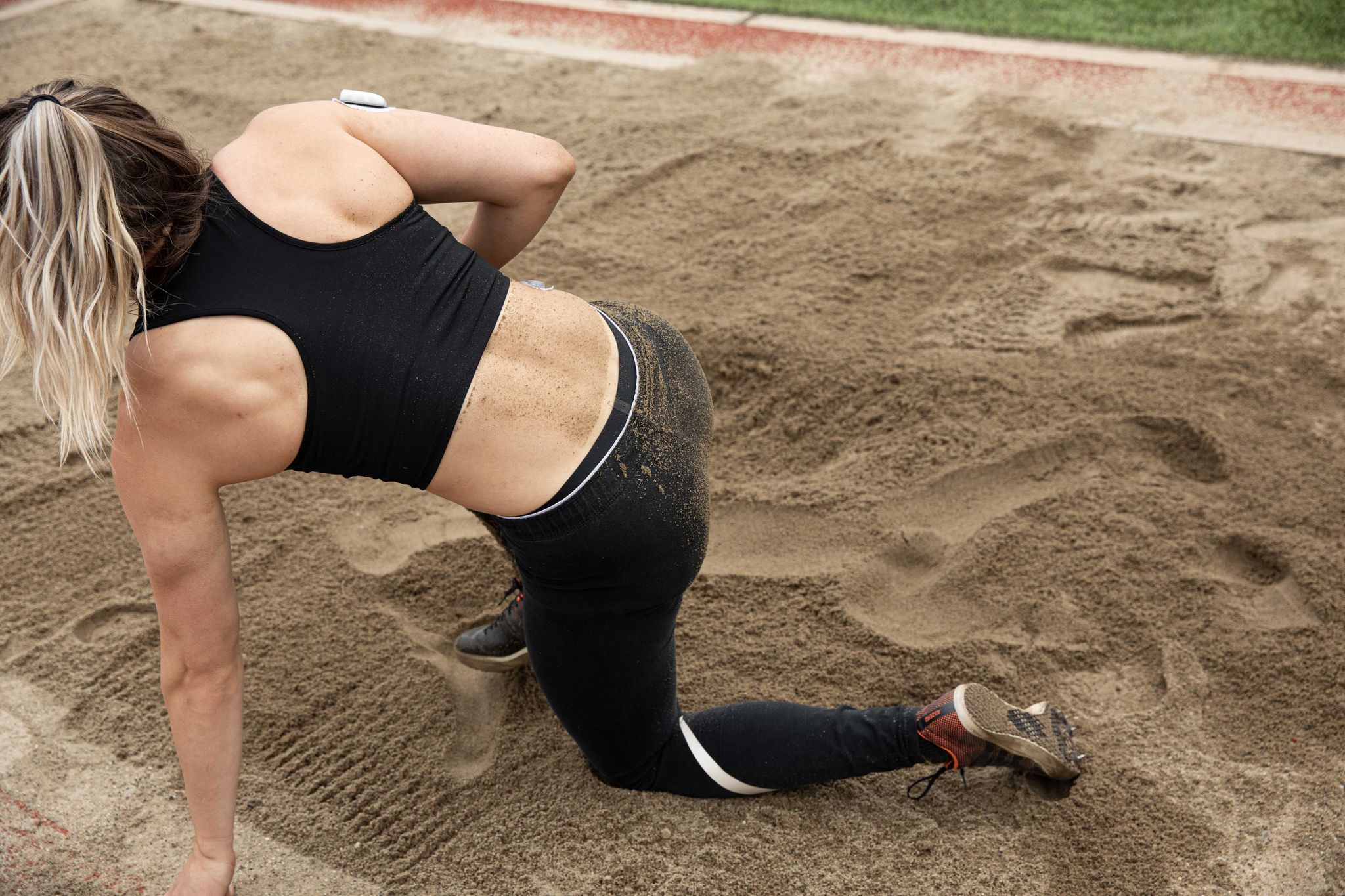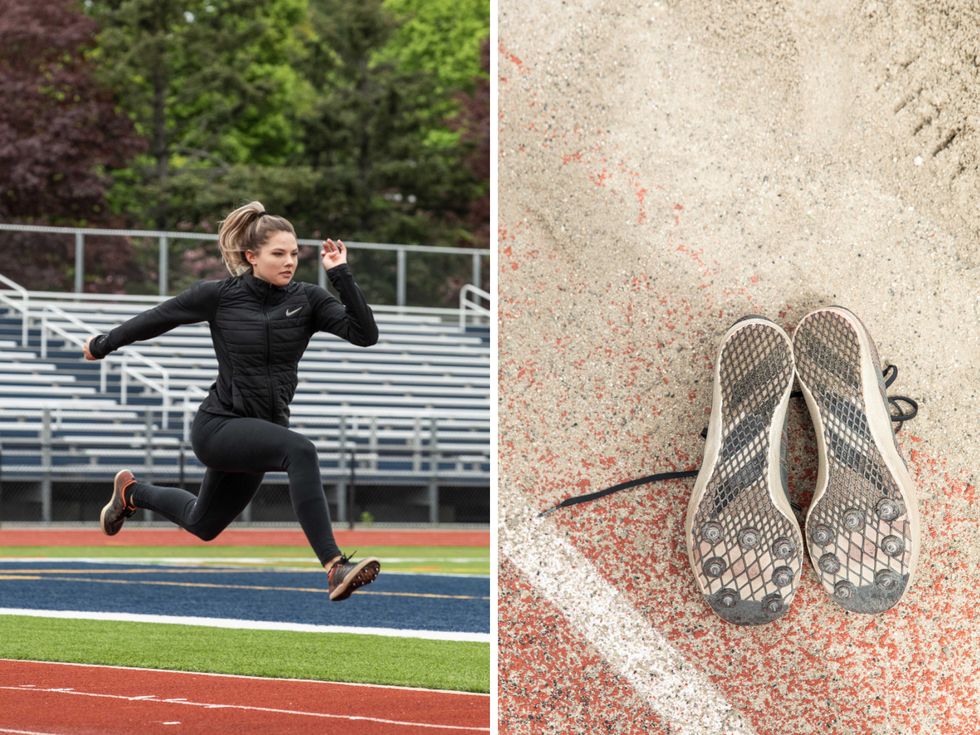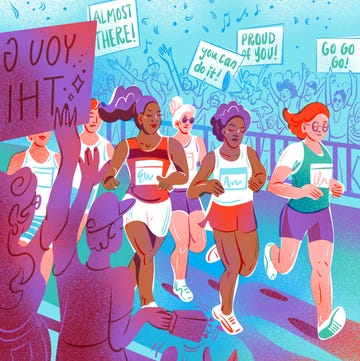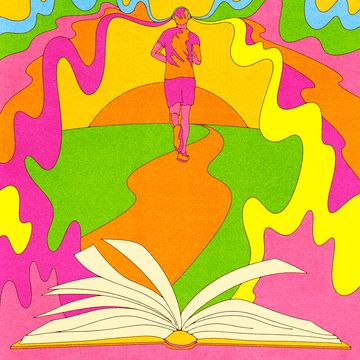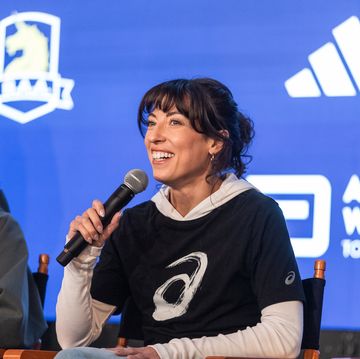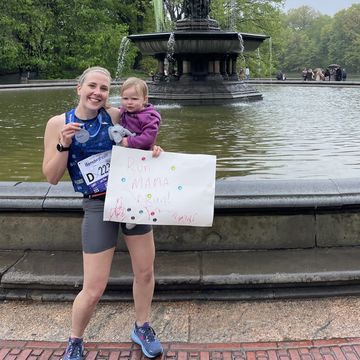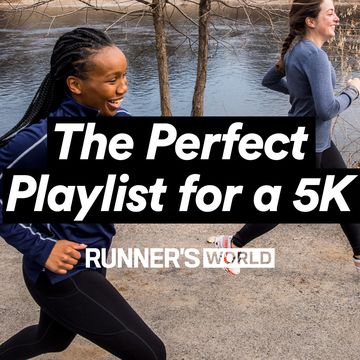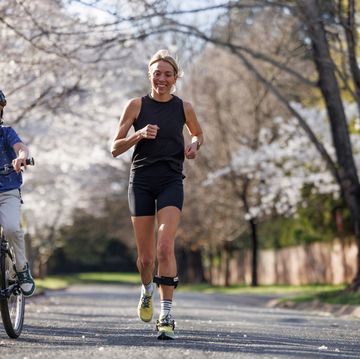You’ll want to be ready if you find yourself on the receiving end of a Kate Hall medicine ball toss.
I wasn’t. During a midday early May workout, Hall recruited me to catch her throws and roll the ball back to her. I moved to the middle of the infield at Fitzpatrick Stadium in Portland, Maine. From just inside the track, Hall sprang forward and heaved the 8-pound ball. Next thing I knew, the ball landed just in front of me, bounced, and crashed into my chest. It left a red mark on my sternum that lingered for a week.
I should have known better. Hall, age 22, is the national high school record-holder in the long jump, a two-time NCAA champion in the event, and this year’s national indoor titlist. Her long jump PR of 6.83 meters is best appreciated by unspooling a tape measure 22 feet, 5 inches and imagining how much of that distance you could cover after a 40-meter run-up. Hall is also an accomplished sprinter, with a 100-meter best of 11.30 and a runner-up finish at 60 meters in February’s indoor nationals.
The medicine ball tosses came at the end of a workout focusing on sprint starts; on some, she bolted from the blocks with such force that her grandfather, standing on the back of the blocks, was knocked off balance. So of course I should have braced myself when this exemplar of power sent a flying object my way.
Hall is exceptional even among her peers. After the 2018 outdoor season, she decided not to return to the University of Georgia for what would have been her senior year. She moved back to her native Maine to resume working with Chris Pribish, an athletic trainer who guided her high school career but who has otherwise never coached a world-class track athlete, and who spends much of his day working with orthopedic rehab clients.
Hall and Pribish hope that their highly individualized approach can put someone training solo, unsponsored, in Maine’s less-than-ideal climate, on this year’s world championships team. And they hope next year to show that Hall, who has type 1 diabetes, can be the first person with the disease known to become a U.S. track and field Olympian.
Growing up, Hall was used to being the quickest kid in school. That doesn’t necessarily mean much in Casco, Maine, which had a population of 3,742 when Hall became a teenager. But it meant something to a natural competitor, so one day in 2007, when the 10-year-old Hall was beaten by another girl at a soccer practice race, she wanted answers. Hall’s father learned the other girl had done a summer track program. He urged her to try track club the following summer.
“I was hesitant to do something new,” Hall says. “I was all set with soccer and basketball. My dad said, ‘Just go and try one practice. If you hate it, you don’t have to come back.’” Hall sampled all of the events, excelled in the sprints and long jump, and told her father she wanted to return. By seventh grade she was competing for state titles. She stopped playing basketball in eighth grade because it interfered with indoor track, and abandoned soccer the following fall to avoid knee injuries.
Hall was obviously a natural, but that doesn’t mean she came to track unprepared. She has a jumper/sprinter’s version of Kenyan kids running to school. “When I was young, every time I went through a door, I would jump up and hit the doorpost,” she says. “I was probably doing hundreds of jumps a day. I sort of started to train myself to develop that springiness.”
In 2012, as a high school freshman, Hall set the goal of qualifying for the 2016 Olympic trials, even though her best long jump at the time was more than three feet shy of the eventual standard of 21 feet, 11 inches. In the final jump of her prep career, at the 2015 New Balance Nationals, Hall soared as she never had before. Her mark of 22 feet, 5 inches broke a 39-year-old national high school record, held by Kate McMillan, who in open competition went on to win silver at the 1976 Olympics. It was a massive improvement in personal terms—she had set her previous outdoor PR of 20 feet, 11 inches just the previous week—and an automatic qualifier for the 2016 trials.
That one jump also marked a great distance between the 18-year-old Hall and her 10-year-old self. It was at age 10 that Hall became uncharacteristically weepy, and started losing weight despite eating and drinking more than usual. A local doctor told her she was having growth spurts. As Hall’s symptoms continued to worsen, her parents turned to Dr. Google, which led to doing an at-home test of her urine’s sugar level. A trip to the hospital later that day resulted in a diagnosis of type 1 diabetes and celiac disease. “As soon as I was diagnosed and got insulin, I gained a ton of weight and was back to normal,” she says.
Being diabetic adds challenges that Hall’s competitors never need worry about. If her blood sugars go too high, the pH level in her muscles can change enough to cause cramping. “She had meets in high school where she took one or two jumps and her blood sugars were over 350 [mg/dl], and she’d be done for the day,” Pribish says. Training was frequently interrupted if Hall’s blood sugars had been too high or too low recently.
There have also been equipment malfunctions. The insulin pump she used to wear was a pager-like device attached to her hip, with a tube that connected to a needle. “Whenever I tried to compete, the whole thing would rip off,” Hall says. She now wears an Omnipod, a 1.5-inch x 2-inch pump that she attaches to her triceps for three days at a time. A discreet glucose monitor she clips to her waistband sends blood sugar readings to her phone. (Before I knew about the set-up, I assumed Hall was checking Instagram when she immediately went to her phone between sprints.)
Between technological advances and greater knowledge about managing her nutrition, Hall is now rarely out of commission because of diabetes. Track meets remain challenging, because the excitement of competition can spike her blood sugar levels. Hall tries to stay calm more than get psyched up for meets.
Hall uses her platform to speak regularly to other diabetics. “The message I’m trying to give is that type 1 diabetes doesn’t have to stop you from doing anything you want to do,” she says. “It doesn’t have to control you. You can control it.”
Indeed, Hall ascribes some of her success to diabetes. “My work ethic stems from being diagnosed when I was 10,” she says. “I’ve had to manage and control this disease from a very young age, and I wanted to do it all on my own.” The initial misdiagnosis contributed to Hall’s sense of self-sufficiency and her skepticism toward authority figures who don’t take her perspective into account. As a teen, Hall was home-schooled. While representing Lake Region High School, she was coached by Pribish and trained on her own, using the school’s track practices as a time to stretch and socialize.
Pribish’s and Hall’s origin story isn’t quite that of Alberto Salazar spotting a young Galen Rupp running laps at soccer practice, but it has the same element of chance. Hall pulled a hamstring sprinting at her seventh grade state meet. She went for physical therapy at a clinic in Windham, the nearest facility to her home. Pribish, now the owner of Momentum Performance and Wellness, in South Portland, was on hand during Hall’s last day of therapy. “I told her dad, ‘She’s not ready to go back to sprinting,’” Pribish says. “I told him the hamstring would tear again if she didn’t do some things differently.”
Halls says of their meeting, “He seemed extremely knowledgeable. He knew a lot about track and other sports and how the body works and moves.” The Halls asked Pribish if he did personal training. They’ve been working together in some capacity for the ensuing nine years.
Hall’s development stalled after high school. As a freshman at Iowa State University, her best outdoor long jump was almost a foot short of her PR. “I had more freedom in high school to pursue my goals,” Hall says.
Pribish says that promises made about him staying involved in Hall’s training weren’t honored. “The training was completely different,” Hall says. Near-daily heavy weight lifting made Hall gain 10 pounds in her upper body. “I got to where I was doing my own thing to correct what they were doing, but then I was doing too much, because my body was already tired. I got heavier and slower and realized Iowa State wasn’t going to work for me.” The only real highlight of the year was fulfilling the goal she had set in ninth grade of competing at the 2016 Olympic Trials, where she placed 10th.
Transferring to the University of Georgia for her sophomore year initially felt like an improvement. Hall enjoyed making friends with her teammates and having people to work out with. She set her still-standing 100-meter PR in May 2017. The following month, she won the outdoor NCAA title in her best jump since high school.
But some of the frustrations of the previous year returned. “I started to become aware that the NCAA is a huge business,” Hall says. “It’s not necessarily about what’s best for the athletes, it’s about scoring points.”
Both schools, she says, ignored that having diabetes means she needs more recovery than most athletes between hard workouts, either on the track or in the gym. “If my blood sugars are really high, there’s all this stuff going on in my body to lower them,” Hall says. That process can hinder aspects of recovery such as lowering muscle tension and increasing glandular activity, which in turn can harm her sleep. “Diabetes affects pretty much everything,” she says.
Despite winning the 2018 indoor NCAA long jump title, Hall didn’t make the final at outdoor NCAAs. For the third of three years in college, she’d seen herself mostly get worse, not better as the schedule moved toward championship season. She often felt exhausted from inadequate recovery and out of touch with her body. “No matter how hard I tried, I couldn’t jump like I used to,” Hall says. “I would visualize it, but when I was on the runway I physically couldn’t do it.” She was constantly on the verge of a serious injury. The emphasis on heavy lifting over bodily balance resulted in the hip and glute of her right leg, which is her takeoff leg for jumping, becoming noticeably larger than her left hip and glute.
Hall decided that staying in the college system would hurt her chances of making the 2020 Olympic team. “I didn’t want to be thrown into the professional world in an Olympic year,” she says. “I wanted a year to learn what it’s like and get experience with the pro schedule, traveling overseas, things like that. I knew I needed to go back to where I know is going to be best for me.” That meant leaving Georgia and the NCAA, and returning to Maine to work with Pribish. She’ll finish her degree in exercise science next spring through online courses with Eastern Oregon University.
The longest Hall has run at once is a mile during a school fitness test. She was more lumbering than lithe when I watched her jog about 300 meters as part of a sprint workout warm-up. “Her body doesn’t like jogging, doesn’t find it comfortable,” Pribish says. “I don’t think she has a slow-twitch muscle fiber in her body.”
Understanding jumper/sprinter training requires setting aside a distance runner’s volume-is-king mindset. Even what many of us think of as interval workouts don’t make sense in Hall’s disciplines. “Sprinting is all about 90 to 100 percent effort,” Pribish says. “The only way you’re going to get faster is teaching the muscles and nervous system how to go at this extremely fast pace. And then you need a very long recovery. It’s not about doing lots of repeats at 80 percent effort. That middle speed breaks you down more than it helps either of the things we’re looking for—maximum efforts or recovery.”
The core of a sprint workout I witnessed was four 25-meter, four 35-meter, and four 50-meter accelerations, with recoveries ranging from three to six minutes. (This was enough time between for girls from a Portland high school to ask Hall for a group photo.) Counting her warm-up jog and a few strideouts, Hall covered less than 800 meters during the two-hour workout.
“A very long recovery” also applies to days. Whereas elite distance runners might cover 10 to 20 miles on their “rest” days, Hall takes the term much more literally. The day after a hard gym or track workout, she’s likely to go to Pribish’s gym for an hour. She’ll do some foam rolling, a few basic mobility exercises, and then mostly lie on a massage table while Pribish does fascial-release and repositioning work on her. If Hall still feels tired or sore the next day, she’ll take another recovery day. What Hall has written about diabetesalso describes her approach to training: “

Scott is a veteran running, fitness, and health journalist who has held senior editorial positions at Runner’s World and Running Times. Much of his writing translates sport science research and elite best practices into practical guidance for everyday athletes. He is the author or coauthor of several running books, including Running Is My Therapy, Advanced Marathoning, and Meb for Mortals. Scott has also written about running for Slate, The Atlantic, the Washington Post, and other members of the sedentary media. His lifetime running odometer is past 110,000 miles, but he’s as much in love as ever.

